Århus
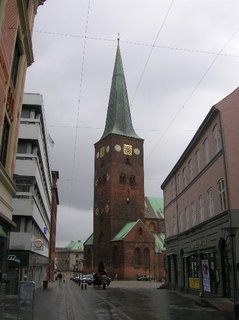 After waking up to a bright morning pierced by the cackling of pheasants again, Ole and Annette and I decided to go into Århus and see the town. Århus is the second largest city in Denmark, trailing Copenhagen...by a fair bit, actually. We drove the few kilometers from Hornslet to Århus, and then got out and roamed the little streets. Here, in the center of town is the central church of Århus.
After waking up to a bright morning pierced by the cackling of pheasants again, Ole and Annette and I decided to go into Århus and see the town. Århus is the second largest city in Denmark, trailing Copenhagen...by a fair bit, actually. We drove the few kilometers from Hornslet to Århus, and then got out and roamed the little streets. Here, in the center of town is the central church of Århus.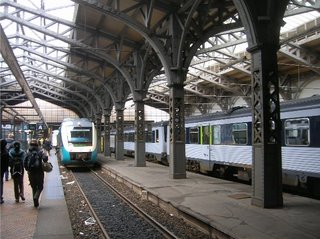 We also swung by the train station to drop off Ole's children, Ida and Mads, and Ida's little toddler, Noah. Lots of emphatic waving to 'farfar' and 'mormor.' As the train rolled out of the station a few minutes later thatn it should have, I looked about this classically European train station and thought, 'so this is the infamous Danish rail system Fred hates so much after his years in Denmark.'
We also swung by the train station to drop off Ole's children, Ida and Mads, and Ida's little toddler, Noah. Lots of emphatic waving to 'farfar' and 'mormor.' As the train rolled out of the station a few minutes later thatn it should have, I looked about this classically European train station and thought, 'so this is the infamous Danish rail system Fred hates so much after his years in Denmark.'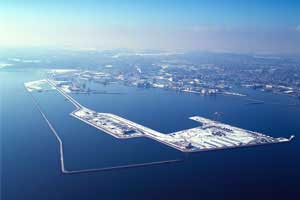 Then, being of nautical minds, Ole and Annette and I drove for the harbor. It is a very interesting time to explore Århus' waterfront as the city is going through a massive port expansion project right now. This aerial photo shows the gigantic new spit of artificial land being laid out across the shallow harbor. By the time we arrived, that entire area inside the little breakwater in the foreground was mostly filled-in with sand.
Then, being of nautical minds, Ole and Annette and I drove for the harbor. It is a very interesting time to explore Århus' waterfront as the city is going through a massive port expansion project right now. This aerial photo shows the gigantic new spit of artificial land being laid out across the shallow harbor. By the time we arrived, that entire area inside the little breakwater in the foreground was mostly filled-in with sand. The sand is picked up from the surrounding harbor bottom by this dredging ship. It has a huge pipe hanging over the starboard bow 'vacuuming up' hundreds of tons of sand and water. From the ship, the churning mixture of sand, mud, water, and ill-fated marine organizms surge through a series of pumps and a long pipeline running to shore. There the whole mess comes gushing out of the pipe in belching, blurping pulses to splatter out upon the rising land inside the empty retaining walls.
The sand is picked up from the surrounding harbor bottom by this dredging ship. It has a huge pipe hanging over the starboard bow 'vacuuming up' hundreds of tons of sand and water. From the ship, the churning mixture of sand, mud, water, and ill-fated marine organizms surge through a series of pumps and a long pipeline running to shore. There the whole mess comes gushing out of the pipe in belching, blurping pulses to splatter out upon the rising land inside the empty retaining walls.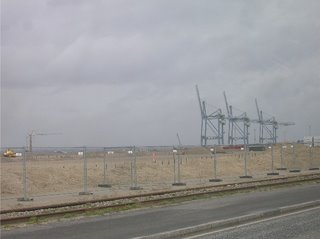 Driving down the road running the length of the artificial causeway (more of a highway than a road because soon it will carry fleets of container trucks), we passed acres and acres of this sand dredged up from the harbor. The entire project must be absolutely devastating for the marine life of Århus harbor. Thousands of acres of benthic ecosystem are being dug up, sucked and blasted through a maze of piping, and then jettisoned out on this big sand pile. The biological deathtoll must be staggering--much to the pleasure of the seagulls swarming the the area for a veritable smörgåsbord of little crustaceans, bivalves, and mud worms blown out of the dredging pipes and scattered across the sandy quay beneath the new cargo container cranes.
Driving down the road running the length of the artificial causeway (more of a highway than a road because soon it will carry fleets of container trucks), we passed acres and acres of this sand dredged up from the harbor. The entire project must be absolutely devastating for the marine life of Århus harbor. Thousands of acres of benthic ecosystem are being dug up, sucked and blasted through a maze of piping, and then jettisoned out on this big sand pile. The biological deathtoll must be staggering--much to the pleasure of the seagulls swarming the the area for a veritable smörgåsbord of little crustaceans, bivalves, and mud worms blown out of the dredging pipes and scattered across the sandy quay beneath the new cargo container cranes.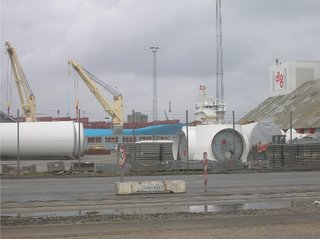 Further along we found that part of this gargantuan ecological disaster (construction project) was already operational...kind of like the Death Star in "Return of the Jedi." Here we witnessed one Denmark's great exports (and ironically, one of its most environmentally sound ones); Pieces of one of the huge wind-turbine generators being lined up for loading onto a ship. Here you see the propeller hub (white thing with the round openings--for the propeller blades--just right of center) and part of the towers (big white pipes). A blue, self-loading freighter awaits in the background.
Further along we found that part of this gargantuan ecological disaster (construction project) was already operational...kind of like the Death Star in "Return of the Jedi." Here we witnessed one Denmark's great exports (and ironically, one of its most environmentally sound ones); Pieces of one of the huge wind-turbine generators being lined up for loading onto a ship. Here you see the propeller hub (white thing with the round openings--for the propeller blades--just right of center) and part of the towers (big white pipes). A blue, self-loading freighter awaits in the background.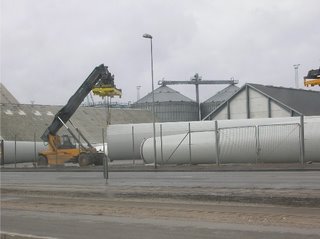 Here you can get an idea of the size of these towers as a hefty forklift tries to raise one end of a tower to transport it to the awaiting freighter.
Here you can get an idea of the size of these towers as a hefty forklift tries to raise one end of a tower to transport it to the awaiting freighter. 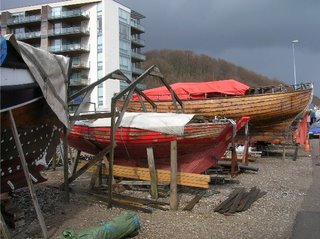 How refreshing!
How refreshing!
Most of the beautiful, little clinker-built boats were just beginning their pre-season maintenance; getting some sanding and filling, a few seams re-caulked, a new plank here and there, and a fresh coat of varnish or paint on the hull. The work had started, but it was a long way from over. Most of the boats were still draped with tarps and as it was only Easter, their admiring owners were just then beginning to brave the cold, windy weather and venture into the boatyard and begin working and dreaming of warm summer breezes.
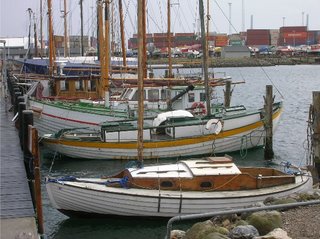 However, a good number of the wooden boats here had endured the harsh winter in their slips at the dock. The marks of that ordeal were visible on many of the boats; varnish bubbled and blacked, paint began to peel, and winter tarps were torn and battered. Despite it all, the dock full of little wooden craft bobbing in the light chop was a pleasing sight--especially after the industrial carnage going on a mile up the shore.
However, a good number of the wooden boats here had endured the harsh winter in their slips at the dock. The marks of that ordeal were visible on many of the boats; varnish bubbled and blacked, paint began to peel, and winter tarps were torn and battered. Despite it all, the dock full of little wooden craft bobbing in the light chop was a pleasing sight--especially after the industrial carnage going on a mile up the shore. In the little fleet at the dock I found yet another classic Danish fishing boat sporting that requisite blue hull paint. However, she was showing the wear of a hard winter more than most with heavy rust streaks runnig down her sides.
In the little fleet at the dock I found yet another classic Danish fishing boat sporting that requisite blue hull paint. However, she was showing the wear of a hard winter more than most with heavy rust streaks runnig down her sides.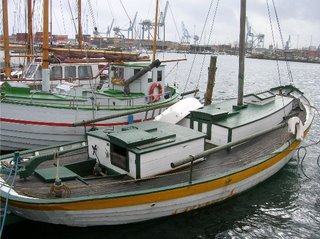 Then I found this little craft with its rather peculiar hull shape--rather like a cockle shell (and not just because of the clinker planking). Ole must have noticed the way I was ducking this way and that, tilting my head left and right like an inquisitive seagull trying to figure out this little craft because he came up and started explaining it. Apparently it is a design from northwestern Denmark and has this broad, flat-bottomed, shallow-draft hull so that it can surf in on the waves and run itself right up on the beach. Then the village fishermen gathe round and shove it up above the high-tide mark (not that western Denmark has much of a tide).
Then I found this little craft with its rather peculiar hull shape--rather like a cockle shell (and not just because of the clinker planking). Ole must have noticed the way I was ducking this way and that, tilting my head left and right like an inquisitive seagull trying to figure out this little craft because he came up and started explaining it. Apparently it is a design from northwestern Denmark and has this broad, flat-bottomed, shallow-draft hull so that it can surf in on the waves and run itself right up on the beach. Then the village fishermen gathe round and shove it up above the high-tide mark (not that western Denmark has much of a tide).Going to sea again is simply a reversal of the process.
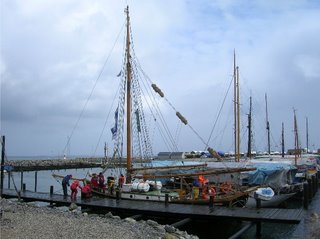 One of the largest and best maintained boats at the dock was this beautiful vessel. She was also the only one with any sign of life onboard. We spoke with the crew--or rather, Annette did. I don't speak a lick of Danish--and discovered theywere just departing for the first run of the season. Ooo...it'll be a cold one...
One of the largest and best maintained boats at the dock was this beautiful vessel. She was also the only one with any sign of life onboard. We spoke with the crew--or rather, Annette did. I don't speak a lick of Danish--and discovered theywere just departing for the first run of the season. Ooo...it'll be a cold one...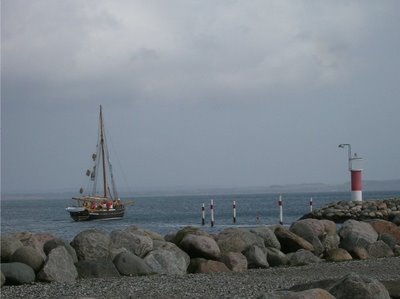
Then, shortly, the fired up the old diesel with a plume of blue smoke, cast off the lines, and wound their way out between the buoys and breakwaters and headed seaward to Sjealland.
Oh, how we envied them....

0 Comments:
Post a Comment
<< Home